
 ORIGINS OF THE K A B B A L A H
ORIGINS OF THE K A B B A L A H  edited by R. J. ZWI WERBLOWSKY translated from the German by ALLAN ARKUSH T H E J E W I S H P U B L I C A T I O N S O C I E T Y P R I N C E T O N U N I V E R S I T Y P R E S S
edited by R. J. ZWI WERBLOWSKY translated from the German by ALLAN ARKUSH T H E J E W I S H P U B L I C A T I O N S O C I E T Y P R I N C E T O N U N I V E R S I T Y P R E S S  ORIGINS OF THE KABBALAH GERSHOM SCHOLEM Originally published in German under the title Ursprung und Anfnge derKabbala Copyright 1962 by Walter de Gruyter & Co. Berlin English translation copyright 1987 by The Jewish Publication Society First English edition All rights reserved Library of Congress Cataloging in Publication Data Scholem, Gershom Gerhard, 1897-1982 Origins of the Kabbalah. Translation of: Ursprung und Anfange der Kabbala. Bibliography: p.
ORIGINS OF THE KABBALAH GERSHOM SCHOLEM Originally published in German under the title Ursprung und Anfnge derKabbala Copyright 1962 by Walter de Gruyter & Co. Berlin English translation copyright 1987 by The Jewish Publication Society First English edition All rights reserved Library of Congress Cataloging in Publication Data Scholem, Gershom Gerhard, 1897-1982 Origins of the Kabbalah. Translation of: Ursprung und Anfange der Kabbala. Bibliography: p.
Includes index. 1. CabalaHistory. 2. Sefer ha-bahir. I.
Werblowsky, R. J. Zwi (Raphael Jehudah Zwi), 1924- . II. Title. BM526.S363513 1987 296.1'6 86-7381 ISBN 0-691-07314-7 Princeton University Press books are printed on acid-free paper and meet the guidelines for permanence and durability of the Committee on Production Guidelines for Book Longevity of the Council on Library Resources http://pup.princeton.edu Designed by ADRIANNE ONDERDONK DUDDEN  ContentsSources ixEditor's Preface xiAuthor's Preface to the First (German) Edition xv
ContentsSources ixEditor's Preface xiAuthor's Preface to the First (German) Edition xv
CHAPTER ONE
T H E P R O B L E M 3
1.
The State of Research: The Views of Graetz and Neumark2. Southern France in the Twelfth Century: The Catharist MovementThe Jews of Languedoc3. The Esoteric Doctrine of the Creation and the Merkabah in Pre-kabbalistic Judaism: The Literature of the Hekhaloth and JewishGnosticism4. The "Book of Creation"5. The Oldest Documents Concerning the Appearance of the Kabbalahand the Publication of the Book Bahir
CHAPTER TWO
THE B O O K
BAHIR 49
1. Literary Character and Structure of the Book: Its Different Strata2.
Gnostic Elements in the Bahir: Pleroma and Cosmic Tree3. Other Gnostic Elements: The Potencies of God Middoth GnosticReinterpretations of Talmudic SayingsThe Double Sophia andthe Symbolism of the Sophia as Daughter and Bride vi Contents4. Identification of Ancient Sources Preserved in the Tradition of theGerman Hasidim: Raza Rabba and Bahir 5. The First Three Sefiroth6. The Six Lower Sefiroth: The Limbs of the Primordial Man and TheirSymbolismThe Place of Evil7. The Syzygy of the Masculine and the Feminine: The Seventh andTenth Sefirah in the Bahir The Symbolism of the Righteous8.
The Symbolism of the Shekhinah and the Feminine: The Jewel9. Elements of the Doctrine of the Aeons Among the German Hasidim10. The Transmigration of Souls and the Mysticism of Prayer in the Bahir
CHAPTER 3
THE F I R S T K A B B A L I S T S IN P R O V E N C E . 199
1. Abraham ben Isaac of Narbonne2. Abraham ben David (Rabad)3.
Jacob the Nazirite and the Groups of Ascetics in the Community, Perushim and Nezirim Catharism and KabbalahRevelationsGranted to the Ascetics and the Forms of These RevelationsTheDoctrine of Kawwanah in Prayer4. Isaac the Blind and His Writings5. Isaac's Doctrine of the 'En-sof and the Sefiroth6. Good and Evil in Isaac and Other Sources7. Isaac's Contemplative Mysticism: Kawwanah and Debhequth 8. The Writings of the ?Iyyun Circle9.
Fundamental Conceptions of This Circle: The Primordial EtherLight- and Language-Mysticism10. The Thirteen Middoth, Ten Sefiroth and Three Lights AboveThem in Pseudo-Hai11. The Sefirotic Doctrines of a Pseudoepigraphic Epistle
CHAPTER 4
THE K A B B A L I S T I C C E N T E R IN G E R O N A - 365
1. The Kabbalists of Gerona and Their Writings2. Debates and Disturbances Resulting from the Propaganda of theKabbalists: Their Role in the Controversy over the Writings ofMaimonides3. Elevation Through Kawwanah:
The Nothing and the Hokhmah
4.
The Doctrines of Azriel and Nahmanides on the Process of EmanationContents vii 'En-sof, the Primordial Will and the Primordial IdeaTheSefiroth5. Man and the Soul6. The Book Temunah and the Doctrine of World Cycles or Shemittoth Index497This Page Intentionally Left Blank SourcesAr.Or. Archiv OrientalniHTR Harvard Theological ReviewHUCA Hebrew Union College AnnualJAOS Journal of the American Oriental SocietyJBL JournaI of BiblicaI LiteratureJJS Journal of Jewish StudiesJQR Jewish Quarterly ReviewJRAS Journal of the Royal Asiatic SocietyMGWJ Monatsschrift fr die Geschichte und Wissenschaft desJudentumsPAAJR Proceedings of the American Academy for Jewish ResearchREJ Revue des tudes juivesRHR Revue de l'Histoire des ReligionsZMRW Zeitschrift fr Missionskunde und ReligionswissenschaftThis Page Intentionally Left Blank
SourcesAr.Or. Archiv OrientalniHTR Harvard Theological ReviewHUCA Hebrew Union College AnnualJAOS Journal of the American Oriental SocietyJBL JournaI of BiblicaI LiteratureJJS Journal of Jewish StudiesJQR Jewish Quarterly ReviewJRAS Journal of the Royal Asiatic SocietyMGWJ Monatsschrift fr die Geschichte und Wissenschaft desJudentumsPAAJR Proceedings of the American Academy for Jewish ResearchREJ Revue des tudes juivesRHR Revue de l'Histoire des ReligionsZMRW Zeitschrift fr Missionskunde und ReligionswissenschaftThis Page Intentionally Left Blank Editor's Preface It is idle to question which of a great scholar's great works is his greatest. In the case of Gershom Scholem, also the opera minora, articles, and essays were "great." But three works stand out not only by virtue of their size, but also by virtue of their impact. Major Trends in Jewish Mysticism (1st ed. 1941) is the first great and still classic attempt to view the whole history of Jewish mysticism in one wide sweep, combining synthetic power with analytical precision and attention to philological detail. Sabbatai Sevi: The Mystical Messiah (original Hebrew ed. 1956; re vised English version 1973) became a best seller not only because of the fascination with its exotic subject matter. 1956; re vised English version 1973) became a best seller not only because of the fascination with its exotic subject matter.
Editor's Preface It is idle to question which of a great scholar's great works is his greatest. In the case of Gershom Scholem, also the opera minora, articles, and essays were "great." But three works stand out not only by virtue of their size, but also by virtue of their impact. Major Trends in Jewish Mysticism (1st ed. 1941) is the first great and still classic attempt to view the whole history of Jewish mysticism in one wide sweep, combining synthetic power with analytical precision and attention to philological detail. Sabbatai Sevi: The Mystical Messiah (original Hebrew ed. 1956; re vised English version 1973) became a best seller not only because of the fascination with its exotic subject matter. 1956; re vised English version 1973) became a best seller not only because of the fascination with its exotic subject matter.
Rarely before had such erudition, quantity and breadth of the sources, minute textual analysis, and profound historical insight been brought to bear on a relatively shortbut nevertheless bizarre, spectacular, and, withal, significantepisode in Jewish history (and the history of messianic movements in general for that matter). Yet in many ways Ursprungund Anfange der Kabbalah (1962) is the most impressive of all, for here Scholem dealt with a major yet enigmatic phenomenon in the history of Jewish spirituality. The very specific form of Jewish mysticism (or mystical theosophy) known as Kabbalah appeared suddenly, as if out of the blue, in the late Middle Ages. What were xii
Next page
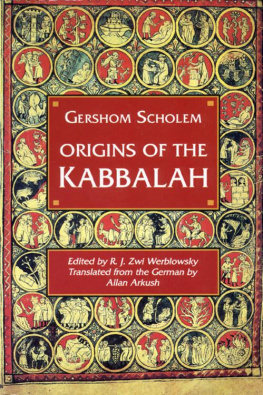

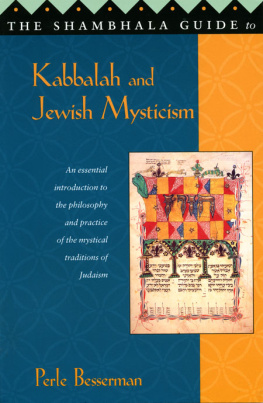
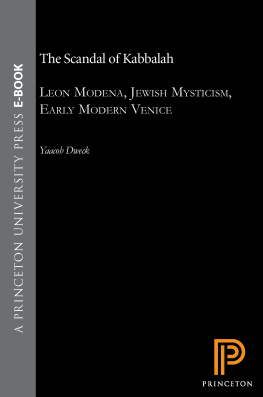
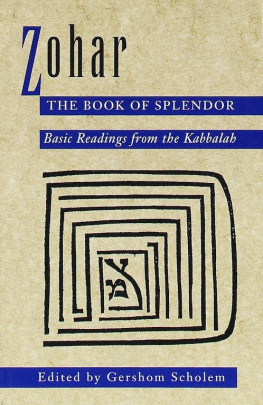
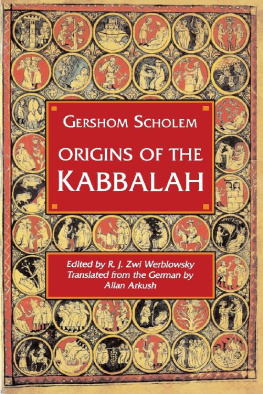

 ORIGINS OF THE K A B B A L A H
ORIGINS OF THE K A B B A L A H  edited by R. J. ZWI WERBLOWSKY translated from the German by ALLAN ARKUSH T H E J E W I S H P U B L I C A T I O N S O C I E T Y P R I N C E T O N U N I V E R S I T Y P R E S S
edited by R. J. ZWI WERBLOWSKY translated from the German by ALLAN ARKUSH T H E J E W I S H P U B L I C A T I O N S O C I E T Y P R I N C E T O N U N I V E R S I T Y P R E S S  ORIGINS OF THE KABBALAH GERSHOM SCHOLEM Originally published in German under the title Ursprung und Anfnge derKabbala Copyright 1962 by Walter de Gruyter & Co. Berlin English translation copyright 1987 by The Jewish Publication Society First English edition All rights reserved Library of Congress Cataloging in Publication Data Scholem, Gershom Gerhard, 1897-1982 Origins of the Kabbalah. Translation of: Ursprung und Anfange der Kabbala. Bibliography: p.
ORIGINS OF THE KABBALAH GERSHOM SCHOLEM Originally published in German under the title Ursprung und Anfnge derKabbala Copyright 1962 by Walter de Gruyter & Co. Berlin English translation copyright 1987 by The Jewish Publication Society First English edition All rights reserved Library of Congress Cataloging in Publication Data Scholem, Gershom Gerhard, 1897-1982 Origins of the Kabbalah. Translation of: Ursprung und Anfange der Kabbala. Bibliography: p. ContentsSources ixEditor's Preface xiAuthor's Preface to the First (German) Edition xv
ContentsSources ixEditor's Preface xiAuthor's Preface to the First (German) Edition xv SourcesAr.Or. Archiv OrientalniHTR Harvard Theological ReviewHUCA Hebrew Union College AnnualJAOS Journal of the American Oriental SocietyJBL JournaI of BiblicaI LiteratureJJS Journal of Jewish StudiesJQR Jewish Quarterly ReviewJRAS Journal of the Royal Asiatic SocietyMGWJ Monatsschrift fr die Geschichte und Wissenschaft desJudentumsPAAJR Proceedings of the American Academy for Jewish ResearchREJ Revue des tudes juivesRHR Revue de l'Histoire des ReligionsZMRW Zeitschrift fr Missionskunde und ReligionswissenschaftThis Page Intentionally Left Blank
SourcesAr.Or. Archiv OrientalniHTR Harvard Theological ReviewHUCA Hebrew Union College AnnualJAOS Journal of the American Oriental SocietyJBL JournaI of BiblicaI LiteratureJJS Journal of Jewish StudiesJQR Jewish Quarterly ReviewJRAS Journal of the Royal Asiatic SocietyMGWJ Monatsschrift fr die Geschichte und Wissenschaft desJudentumsPAAJR Proceedings of the American Academy for Jewish ResearchREJ Revue des tudes juivesRHR Revue de l'Histoire des ReligionsZMRW Zeitschrift fr Missionskunde und ReligionswissenschaftThis Page Intentionally Left Blank Editor's Preface It is idle to question which of a great scholar's great works is his greatest. In the case of Gershom Scholem, also the opera minora, articles, and essays were "great." But three works stand out not only by virtue of their size, but also by virtue of their impact. Major Trends in Jewish Mysticism (1st ed. 1941) is the first great and still classic attempt to view the whole history of Jewish mysticism in one wide sweep, combining synthetic power with analytical precision and attention to philological detail. Sabbatai Sevi: The Mystical Messiah (original Hebrew ed. 1956; re vised English version 1973) became a best seller not only because of the fascination with its exotic subject matter. 1956; re vised English version 1973) became a best seller not only because of the fascination with its exotic subject matter.
Editor's Preface It is idle to question which of a great scholar's great works is his greatest. In the case of Gershom Scholem, also the opera minora, articles, and essays were "great." But three works stand out not only by virtue of their size, but also by virtue of their impact. Major Trends in Jewish Mysticism (1st ed. 1941) is the first great and still classic attempt to view the whole history of Jewish mysticism in one wide sweep, combining synthetic power with analytical precision and attention to philological detail. Sabbatai Sevi: The Mystical Messiah (original Hebrew ed. 1956; re vised English version 1973) became a best seller not only because of the fascination with its exotic subject matter. 1956; re vised English version 1973) became a best seller not only because of the fascination with its exotic subject matter.